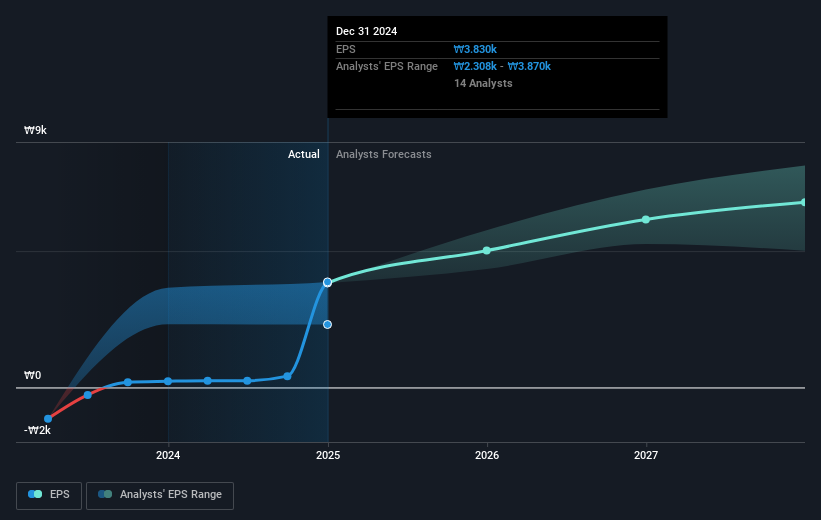- South Korea
- /
- Personal Products
- /
- KOSE:A161890
Kolmar Korea's (KRX:161890) three-year earnings growth trails the favorable shareholder returns

One simple way to benefit from the stock market is to buy an index fund. But if you buy good businesses at attractive prices, your portfolio returns could exceed the average market return. For example, Kolmar Korea Co., Ltd. (KRX:161890) shareholders have seen the share price rise 90% over three years, well in excess of the market decline (4.0%, not including dividends). However, more recent returns haven't been as impressive as that, with the stock returning just 58% in the last year, including dividends.
Since it's been a strong week for Kolmar Korea shareholders, let's have a look at trend of the longer term fundamentals.
Our free stock report includes 2 warning signs investors should be aware of before investing in Kolmar Korea. Read for free now.To quote Buffett, 'Ships will sail around the world but the Flat Earth Society will flourish. There will continue to be wide discrepancies between price and value in the marketplace...' One way to examine how market sentiment has changed over time is to look at the interaction between a company's share price and its earnings per share (EPS).
Kolmar Korea was able to grow its EPS at 35% per year over three years, sending the share price higher. The average annual share price increase of 24% is actually lower than the EPS growth. Therefore, it seems the market has moderated its expectations for growth, somewhat.
The image below shows how EPS has tracked over time (if you click on the image you can see greater detail).

We know that Kolmar Korea has improved its bottom line over the last three years, but what does the future have in store? You can see how its balance sheet has strengthened (or weakened) over time in this free interactive graphic.
What About Dividends?
It is important to consider the total shareholder return, as well as the share price return, for any given stock. Whereas the share price return only reflects the change in the share price, the TSR includes the value of dividends (assuming they were reinvested) and the benefit of any discounted capital raising or spin-off. Arguably, the TSR gives a more comprehensive picture of the return generated by a stock. In the case of Kolmar Korea, it has a TSR of 97% for the last 3 years. That exceeds its share price return that we previously mentioned. And there's no prize for guessing that the dividend payments largely explain the divergence!
A Different Perspective
We're pleased to report that Kolmar Korea shareholders have received a total shareholder return of 58% over one year. And that does include the dividend. That gain is better than the annual TSR over five years, which is 14%. Therefore it seems like sentiment around the company has been positive lately. Someone with an optimistic perspective could view the recent improvement in TSR as indicating that the business itself is getting better with time. It's always interesting to track share price performance over the longer term. But to understand Kolmar Korea better, we need to consider many other factors. For example, we've discovered 2 warning signs for Kolmar Korea (1 is potentially serious!) that you should be aware of before investing here.
Of course, you might find a fantastic investment by looking elsewhere. So take a peek at this free list of companies we expect will grow earnings.
Please note, the market returns quoted in this article reflect the market weighted average returns of stocks that currently trade on South Korean exchanges.
Valuation is complex, but we're here to simplify it.
Discover if Kolmar Korea might be undervalued or overvalued with our detailed analysis, featuring fair value estimates, potential risks, dividends, insider trades, and its financial condition.
Access Free AnalysisHave feedback on this article? Concerned about the content? Get in touch with us directly. Alternatively, email editorial-team (at) simplywallst.com.
This article by Simply Wall St is general in nature. We provide commentary based on historical data and analyst forecasts only using an unbiased methodology and our articles are not intended to be financial advice. It does not constitute a recommendation to buy or sell any stock, and does not take account of your objectives, or your financial situation. We aim to bring you long-term focused analysis driven by fundamental data. Note that our analysis may not factor in the latest price-sensitive company announcements or qualitative material. Simply Wall St has no position in any stocks mentioned.
About KOSE:A161890
Kolmar Korea
Researches, develops, produces, and sells beauty and health products in South Korea and internationally.
Acceptable track record with mediocre balance sheet.
Similar Companies
Market Insights
Community Narratives



